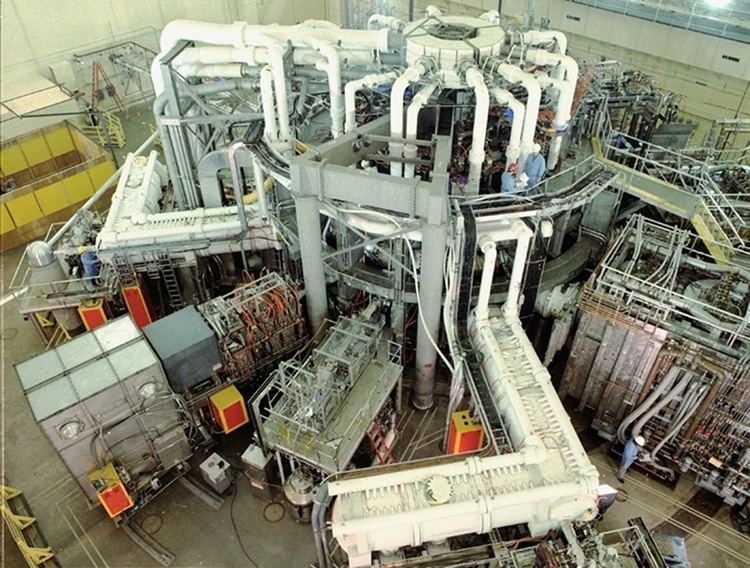Type Tokamak Major radius 2.1–3.1 m Magnetic field 6.0 T (toroidal) | Operation date 1982–1997 Minor Radius 0.4–0.96 m Heating 51 MW | |
 | ||
The Tokamak Fusion Test Reactor (TFTR) was an experimental tokamak built at Princeton Plasma Physics Laboratory (in Princeton, New Jersey) circa 1980. Following on from the PDX (Poloidal Diverter Experiment) and PLT (Princeton Large Torus) devices, it was hoped that TFTR would finally achieve fusion energy break-even. Unfortunately, the TFTR never achieved this goal. However it did produce major advances in confinement time and energy density, which ultimately contributed to the knowledge base necessary to build ITER. TFTR operated from 1982 to 1997.
Contents
TFTR was the world's first magnetic fusion device to perform extensive scientific experiments with plasmas composed of 50/50 deuterium/tritium (D-T), the fuel mix required for practical fusion power production, and also the first to produce more than 10 million watts of fusion power.
General
In nuclear fusion, there are two types of reactors stable enough to conduct fusion: magnetic confinement reactors and inertial confinement reactors. The former method of fusion seeks to lengthen the time that ions spend close together in order to fuse them together, while the latter aims to fuse the ions so fast that they do not have time to move apart. Inertial confinement reactors, unlike magnetic confinement reactors, use laser fusion and ion-beam fusion in order to conduct fusion. However, with magnetic confinement reactors you avoid the problem of having to find a material that can withstand the high temperatures of nuclear fusion reactions.The heating current is induced by the changing magnetic fields in central induction coils and exceeds a million amperes. Magnetic fusion devices keep the hot plasma out of contact with the walls of its container by keeping it moving in circular or helical paths by means of the magnetic force on charged particles and by a centripetal force acting on the moving particles.
Results - History
In 1986 it produced the first 'supershots' which produced many more fusion neutrons.
In experiments conducted during July 1986, the TFTR achieved a plasma temperature of 200 million kelvin (200 MK). This temperature was the highest ever reached in a laboratory. The temperature is 10 times greater than the center of the sun, but more important, it is more than enough for breakeven, which is the point where fusion produce as much energy needed to be expended to ignite them. Besides temperature, break-even requires another criterion: the product of plasma density and confinement time, usually called the triple product.
In April 1986, TFTR experiments at lower temperatures produced a triple product of 1.5 x 1014 seconds per cubic centimeter, which is close to the goal for a practical reactor and five to seven times what is needed for break-even. However, the 200-MK experiments had a triple product of 1013, two or three times too small for break-even. The next step for the physicists working at TFTR was to put the high values together and get break-even. Donald Grove, TFTR project manager, said they expected to achieve that goal in 1987 using the hydrogen isotope deuterium, with which they had been working with so far. Then they intended to introduce another hydrogen isotope, tritium. Deuterium-tritium fusion, which most controlled fusion experiments today are trying to achieve, produces energetic neutrons, from which energy can easily be harvested and converted to useful things like steam or electric power. Physicists hoped to achieve deuterium-tritium break-even in 1989.
In December, 1993, TFTR became the world's first magnetic fusion device to perform extensive experiments with plasmas composed of 50/50 deuterium/tritium. In 1994 it produced a then world-record of 10.7 megawatts of fusion power from a plasma composed of equal parts of deuterium and tritium (exceeded at JET in the UK, which generated 16MW for 22MW input in 1997, which is the current record). The two experiments had emphasized the alpha particles produced in the deuterium-tritium reactions. It was followed by the NSTX spherical tokamak.
In 1995, TFTR attained a world-record temperature of 510 million °C - more than 25 times that at the center of the sun. Also In 1995, TFTR scientists explored a new fundamental mode of plasma confinement -- enhanced reversed shear, to reduce plasma turbulence.
1997: end of plasma operations.
In September 2002, staff completed the dismantling and removal of the Tokamak Fusion Test Reactor, which shut down in 1997 following 15 years of operation.
